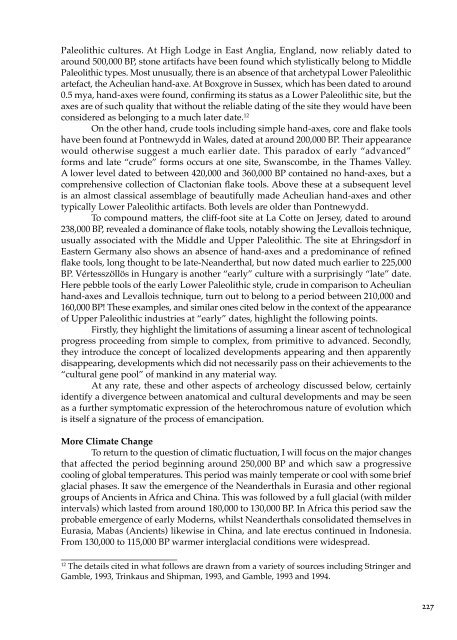The Spirit in Human Evolution - Waldorf Research Institute
The Spirit in Human Evolution - Waldorf Research Institute
The Spirit in Human Evolution - Waldorf Research Institute
You also want an ePaper? Increase the reach of your titles
YUMPU automatically turns print PDFs into web optimized ePapers that Google loves.
Paleolithic cultures. At High Lodge <strong>in</strong> East Anglia, England, now reliably dated to<br />
around 500,000 BP, stone artifacts have been found which stylistically belong to Middle<br />
Paleolithic types. Most unusually, there is an absence of that archetypal Lower Paleolithic<br />
artefact, the Acheulian hand-axe. At Boxgrove <strong>in</strong> Sussex, which has been dated to around<br />
0.5 mya, hand-axes were found, confirm<strong>in</strong>g its status as a Lower Paleolithic site, but the<br />
axes are of such quality that without the reliable dat<strong>in</strong>g of the site they would have been<br />
considered as belong<strong>in</strong>g to a much later date. 12<br />
On the other hand, crude tools <strong>in</strong>clud<strong>in</strong>g simple hand-axes, core and flake tools<br />
have been found at Pontnewydd <strong>in</strong> Wales, dated at around 200,000 BP. <strong>The</strong>ir appearance<br />
would otherwise suggest a much earlier date. This paradox of early “advanced”<br />
forms and late “crude” forms occurs at one site, Swanscombe, <strong>in</strong> the Thames Valley.<br />
A lower level dated to between 420,000 and 360,000 BP conta<strong>in</strong>ed no hand-axes, but a<br />
comprehensive collection of Clactonian flake tools. Above these at a subsequent level<br />
is an almost classical assemblage of beautifully made Acheulian hand-axes and other<br />
typically Lower Paleolithic artifacts. Both levels are older than Pontnewydd.<br />
To compound matters, the cliff-foot site at La Cotte on Jersey, dated to around<br />
238,000 BP, revealed a dom<strong>in</strong>ance of flake tools, notably show<strong>in</strong>g the Levallois technique,<br />
usually associated with the Middle and Upper Paleolithic. <strong>The</strong> site at Ehr<strong>in</strong>gsdorf <strong>in</strong><br />
Eastern Germany also shows an absence of hand-axes and a predom<strong>in</strong>ance of ref<strong>in</strong>ed<br />
flake tools, long thought to be late-Neanderthal, but now dated much earlier to 225,000<br />
BP. Vértesszöllös <strong>in</strong> Hungary is another “early” culture with a surpris<strong>in</strong>gly “late” date.<br />
Here pebble tools of the early Lower Paleolithic style, crude <strong>in</strong> comparison to Acheulian<br />
hand-axes and Levallois technique, turn out to belong to a period between 210,000 and<br />
160,000 BP! <strong>The</strong>se examples, and similar ones cited below <strong>in</strong> the context of the appearance<br />
of Upper Paleolithic <strong>in</strong>dustries at “early” dates, highlight the follow<strong>in</strong>g po<strong>in</strong>ts.<br />
Firstly, they highlight the limitations of assum<strong>in</strong>g a l<strong>in</strong>ear ascent of technological<br />
progress proceed<strong>in</strong>g from simple to complex, from primitive to advanced. Secondly,<br />
they <strong>in</strong>troduce the concept of localized developments appear<strong>in</strong>g and then apparently<br />
disappear<strong>in</strong>g, developments which did not necessarily pass on their achievements to the<br />
“cultural gene pool” of mank<strong>in</strong>d <strong>in</strong> any material way.<br />
At any rate, these and other aspects of archeology discussed below, certa<strong>in</strong>ly<br />
identify a divergence between anatomical and cultural developments and may be seen<br />
as a further symptomatic expression of the heterochromous nature of evolution which<br />
is itself a signature of the process of emancipation.<br />
More Climate Change<br />
To return to the question of climatic fluctuation, I will focus on the major changes<br />
that affected the period beg<strong>in</strong>n<strong>in</strong>g around 250,000 BP and which saw a progressive<br />
cool<strong>in</strong>g of global temperatures. This period was ma<strong>in</strong>ly temperate or cool with some brief<br />
glacial phases. It saw the emergence of the Neanderthals <strong>in</strong> Eurasia and other regional<br />
groups of Ancients <strong>in</strong> Africa and Ch<strong>in</strong>a. This was followed by a full glacial (with milder<br />
<strong>in</strong>tervals) which lasted from around 180,000 to 130,000 BP. In Africa this period saw the<br />
probable emergence of early Moderns, whilst Neanderthals consolidated themselves <strong>in</strong><br />
Eurasia, Mabas (Ancients) likewise <strong>in</strong> Ch<strong>in</strong>a, and late erectus cont<strong>in</strong>ued <strong>in</strong> Indonesia.<br />
From 130,000 to 115,000 BP warmer <strong>in</strong>terglacial conditions were widespread.<br />
_________________________<br />
12<br />
<strong>The</strong> details cited <strong>in</strong> what follows are drawn from a variety of sources <strong>in</strong>clud<strong>in</strong>g Str<strong>in</strong>ger and<br />
Gamble, 1993, Tr<strong>in</strong>kaus and Shipman, 1993, and Gamble, 1993 and 1994.<br />
227
















